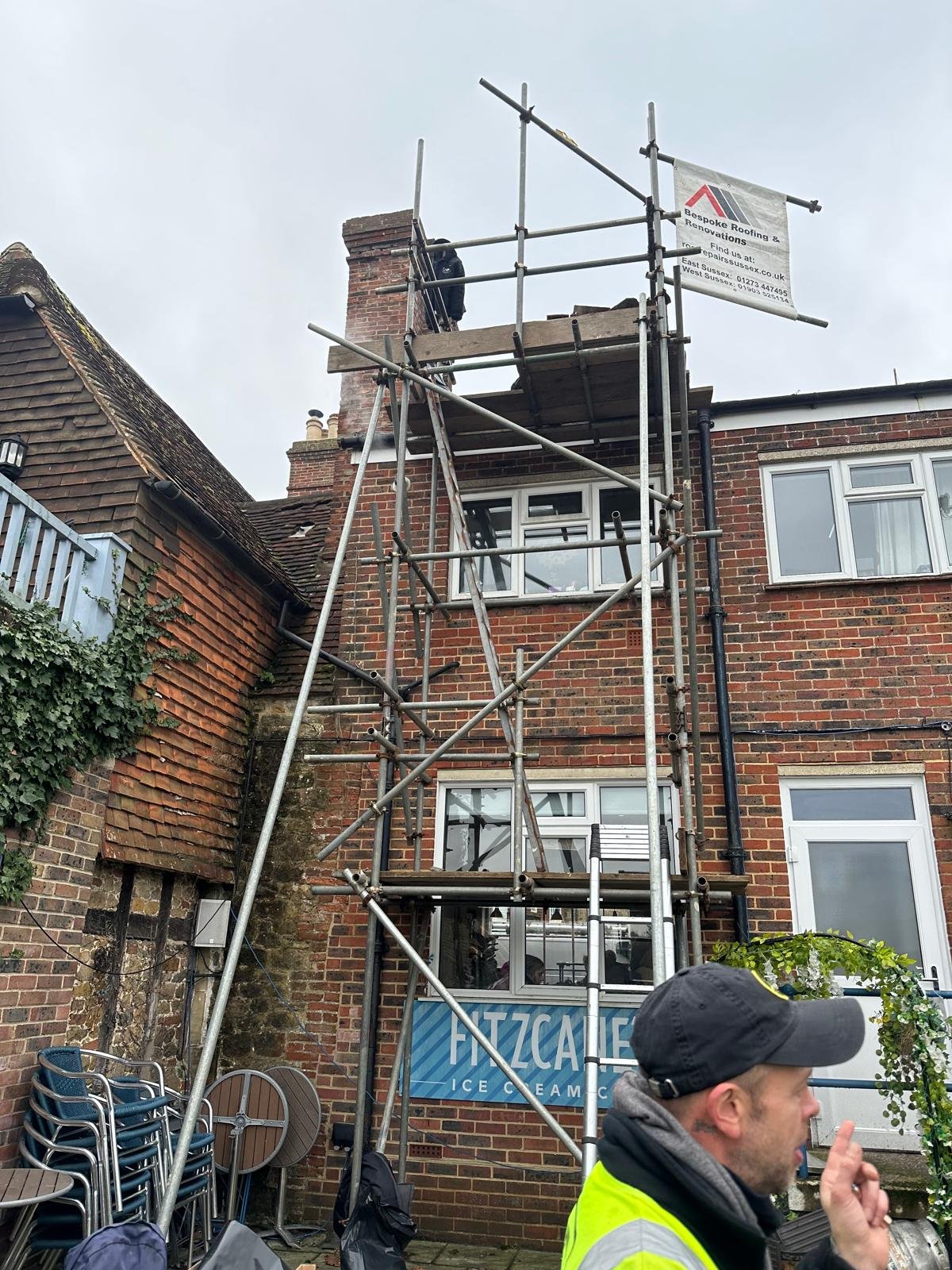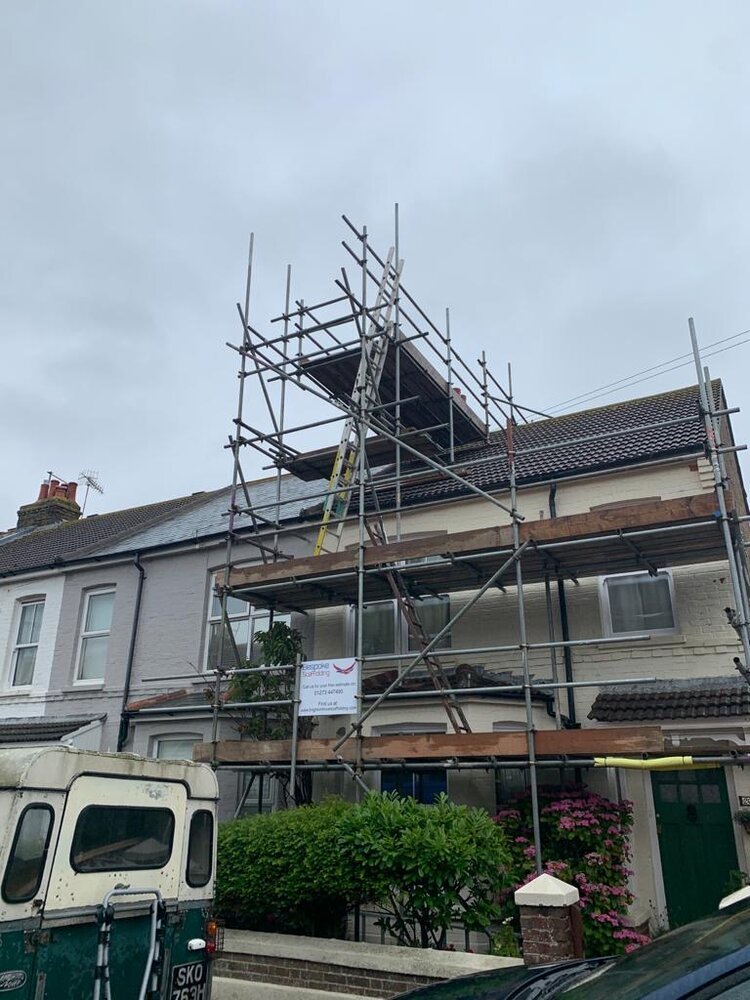Roofing in Lancing
WE OFFER ALL YOUR ROOFING REQUIREMENTS IN Lancing, PLEASE CONTACT US FOR A FREE QUOTATION ON 01903 958694.
We cover all types of roof repairs in Lancing.
CLICK ON THE PRODUCT FOR YOUR REQUIREMENT
New Roofs Lancing
New Roof Lining Lancing
Chimney Repairs Lancing
Moss Removal Lancing
Valley Replacements Lancing
Hip, Ridge and Bonnet tiles Lancing
GRP FLAT ROOFS Lancing
FELT FLAT ROOF Lancing
Domestic Gutter Lining Lancing
UPVC PLASTICS Lancing
Types of roof repairs in Lancing.
Lancing Roof Lining
Felt lining on a roof becomes worn over time, especially the older non breathable membrane (bitumen based.)
At Bespoke Roofing LTD we are able to offer the roofing service for a new breathable membrane to be installed on your property.
You may not be aware but ventilation cannot be installed without having a breathable membrane lining, as this causes condensation in your roof space which can appear as a leak!
I would recommend this service to any client who's roof tiles are in good condition but the felt underneath has become dilapidated and also those who wish to install ventilation within their roof space.
Lancing Chimney repairs.
Chimney stacks are one of the main causes for leaks into an internal property.
The following issues are the most common to identify.
Chimney Pointing - Age plays a significant factor in the state of the mortar on your chimney. Once your mortar is a certain age it will begin to crack and allow water into your internal property.
Chimney Rendering - Once again age is a significant factor in the state of the render on your chimney. If the render begins to crack this will allow water to travel and sit between your brickwork, eventually leading to water penetration.
Chimney Flaunching - The chimney flaunching sometimes known as a coping is the top section of mortar that allows your pots to be bedded correctly, but also is laid to a fall allowing water to travel off the top of your stack.
Chimney Pots & Cowls - Chimney pots and cowls can become cracked with age, and driving rain can also cause ingress of water should a chimney cowl not be installed.
Lead Flashings - Lead on average has a life span of 20-30 years dependent on its grade. Over time lead expands and retracts with heat and can begin to crack and malign.
Lancing Moss Removal.
Moss, algae and lichen build up can be a big problem for homeowners, not only can it hold water on your roof but also once it falls can block guttering and downpipes preventing free flowing water.
There are a few methods in which we are able to offer in order to remove this from your roof.
The first method is a standard dry scrape - manually removing all moss, algae and lichens from your roof.
The second method is to jet wash and seal.
A manual dry scrape is performed first removing all moss, algae and lichens from your roof.
Once all moss is removed a high powered jet wash is performed with an anti fungal wash to all pitched roofing elevations required.
Once dry we use a high quality roofing sealant to aid in prevention of re-growth and ensure that the roof is 100% clean.
Lancing valley repairs/replacements.
There are a few different ways a valley can be installed.
The most common types of valley are tiled valleys, lead valleys and fibreglass valley.
At Bespoke Roofing we are able to offer all of these option but can depend upon the gradient that your valley is positioned.
In most cases we would also change the roof lining a metre either side of the valley so we can be confident that it is completely weathered.
Lancing ridge, hip and bonnet repairs.
Ridge, hip, and bonnet tiles are fundamental materials that form the external structure of your roof.
Ridge and hip lines can be formed using either a mortar mix or a dry ridge system, with bonnet tiles being formed using a mortar mix.
The most common method of laying ridge, hips and bonnets is using a mortar mix, which in time can deteriorate through weathering.
This is one of our most common repairs as the mortar begins to age well before the tile itself in most cases.
The ridge, hip and bonnet tiles can also deteriorate through age and we also offer the service to replace the tile itself depending on its condition.
Another common roofing issue is through storm damage where tiles can be stripped from the roof in high winds, and therefore require replacing - mainly through insurance.
We at Bespoke Roofing offer all types of repairs, from full ridge, bonnet and hip lines to single tile replacements.
GRP Fibreglass Flat Roofing Lancing
Flat roofs can be a real problem in Steyning when they have aged, particularly on the south coast and where high winds and rain can cause severe damage.
Under these conditions there is a very high chance they can crack and cause leaks - a big problem for home owners.
As a business, we provide a service that not only prevents this kind of problem but one we are confident and happy we will not be coming back to once work in Steyning is complete.
Flat roofs can be a real problem when they have aged, particularly on the south coast and where high winds and rain can cause severe damage.
Under these conditions there is a very high chance they can crack and cause leaks - a big problem for home owners.
As a business, we provide a service that not only prevents this kind of problem but one we are confident and happy we will not be coming back to once work is complete.
History of roofing Lancing
Roofing in Lancing has a rich history that parallels the development of the region itself. Lancing, situated along the southern coast of England, has seen various architectural styles and roofing materials evolve over the centuries, reflecting both local and broader trends in building practices.
The history of roofing in Lancing can be traced back to its early settlement periods, where thatched roofs were common among the humble dwellings in the area. Thatching involved using local materials such as straw, reed, or rushes, which were readily available and provided a natural insulation effect. This method remained prevalent until the adoption of more durable roofing materials in the following centuries.
As Lancing developed as a village, particularly in the medieval period, the use of tiles became more prominent. The introduction of clay tiles provided a lasting and weather-resistant option, suitable for the maritime climate. This innovation coincided with broader architectural trends across England as towns and villages sought to enhance their aesthetic appeal and resilience to the elements.
A significant landmark in Lancing is Lancing College, founded in 1848. This prestigious institution is noted for its stunning Gothic architecture, designed by architect Sir George Gilbert Scott. The roofing of Lancing College exemplifies the high-quality craftsmanship and intricate design of the Victorian era. The college features a striking slate roof that is not only functional but also contributes to the building's dramatic silhouette against the landscape. The use of slate, a durable and water-resistant material, marked a shift towards more long-lasting roofing solutions in the 19th century.
As the 20th century approached, roofing practices in Lancing began to reflect advancements in construction technology and materials. The introduction of asphalt and fiberglass roofing systems offered homeowners additional options that were both practical and cost-effective. The post-war period also saw a surge in new housing developments, which commonly featured pitched roofs with interlocking tiles, adapting traditional styles to contemporary needs.
In modern times, Lancing continues to honor its architectural heritage while embracing innovative roofing solutions. Today, roofing professionals employ various techniques and materials that ensure durability and efficiency. Local companies, including family-run firms, play a significant role in maintaining and repairing the roofs of both historic and new buildings in the area.
Overall, the history of roofing in Lancing, marked by its evolution from thatched cottages to the elegant slate roofs of Lancing College, reflects the broader changes in society, economy, and technology throughout the centuries. As the community continues to grow, it remains a testament to the craftsmanship and progressive spirit of the region.











